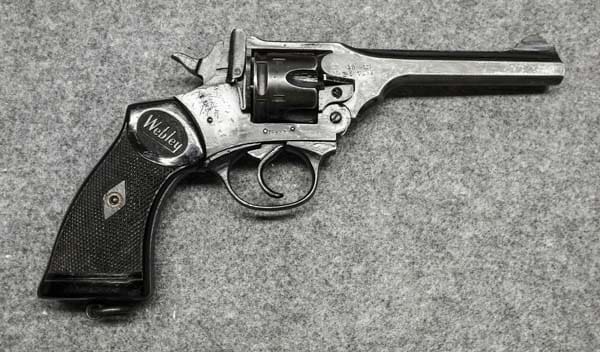
(This is a reader-submitted review as part of our gun review contest. See details here.)
By Kevin DeCausemacker
I am a huge fan of curio and relic firearms, words like cosmoline and Bakelite get me more excited than they probably should. Now, don’t get me wrong, I’d love to own the un-used Black Widow P08 that your cousin’s uncle’s half-brother pulled off an SS officer during Operation Market Garden, but I don’t have $15,000 right now. Not only that, I’m here to shoot. Holster wear, awkward actions, obscure designs, and a cornucopia of calibers just adds to the fun.
But beyond the mechanics of a firearm and the actual shooting, I enjoy the connection I feel to our collective past. Every time I shoot a 70-year-old firearm, I’m reminded of the often innovative, sometimes tragic, and always humbling path we took to get here.
Today, we are heading to post-WWI Great Britain. So throw on your time-traveling khakis, grab some fish and chips, and pour yourself a pint. My writing companion today is a Scotch Ale by Stone Corral Brewery out of Richmond, VT. This one is easy to drink, packs a big malt punch, a little smokiness, and is a bit sweeter than I was expecting. (Please note: I have no affiliation with any brewery, but rather an affinity and appreciation for the hoppy and malty offerings that Vermont provides.)
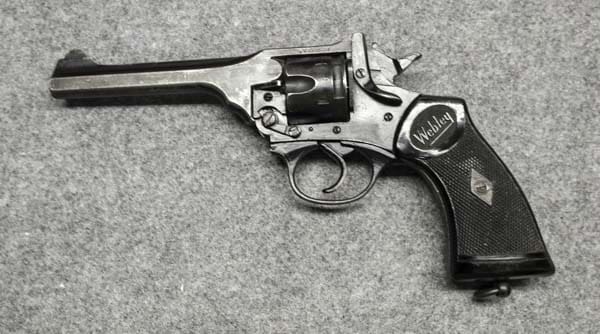
History!
After the First World War, Europe was scarred and shaken. While the Bolsheviks were causing some trouble on the Eastern part of the continent, the British brass were evaluation their situation. The Enfield No 1 Mk III was getting an upgrade, and they also felt that something had to be done with their standard issue sidearm, the Webley Mk VI in .455.
World War I forced Britain to rely heavily on conscripted troops who had limited training. They believed that such troops were ill-equipped to handle the .455, so they changed up the cartridge. They went from a .455 caliber lead bullet weighing in at 265 gr. to a modified .38 S&W round. The new round featured a .38 caliber lead bullet totaling 200 gr. (thus the classification of .38/200 or 380/200).
Smaller bullet plus same velocity (we’re talking in the 600-700fps range) plus smaller gun equals OK for conscripted troops. Made sense at the time…I suppose. Eventually the bullet was jacketed and reduced to around 180 gr. or so (the rules set at the Hague Convention didn’t like soft lead bullets that expanded and stayed lodged in the enemy combatant).
Who better to design such a novel firearm than the blokes at Webley and Scott? I’m pretty sure the design and acceptance phase went something like this:
Webley: Hey guys, here’s the new revolver in the .38 caliber cartridge. Pretty sweet, right? It’s just like our Mk VI in .455, only smaller!
British Brass: Jolly good! We’ll test it out right away! Psst! Hey Enfield, can you make this exact same revolver only slightly different?
Enfield: Sure! Here it is: The Enfield No 2 Mk 1. It’s different-ish enough from Webley’s design. (Officially adopted in 1932. Cool history on this revolver too…a story for another time perhaps.)
British Brass: Hey Webley, Enfield did this totally on their own without copying anyone. Terribly sorry, but we’re giving the contract to produce the military small arms to them.
Webley: Wankers. We’re totally suing for research and design expenses.
British Brass: Yeah…Don’t care. (They eventually settled with Webley.)
World War II Breaks Out
Enfield: Hey, a slight issue. Um, we’re having just a little trouble producing enough No 2 Mk I’s to meet demand…so… (They produced approximately 270,000 from 1932 to 1957.)
British Brass: -sigh- Good afternoon Webley, it’s us….do you think you guys could start making some of those .38 caliber revolvers?
Webley: Yup. That’s kind of what we wanted to do from the beginning. Anyway, since we’re going to rush things a bit, we’re going to stamp “War Finish” on the left side of the revolver, just so people know this isn’t our normal, exquisite work. (They would go on to produce approximately 500,000 between 1932 and 1978. Pre-war production was for police.)
British Brass: Great! We’re going to put a ton of markings on there too! Like “tonnes” and crowns and stuff.
How’s it work?
Ever since I saw Indiana Jones break open his revolver in ‘The Last Crusade’ I have been itching to try one. (Why was he carrying around a giant unloaded revolver?)
The operation of the Webley is quite simple. Put your thumb on the latch, and push:
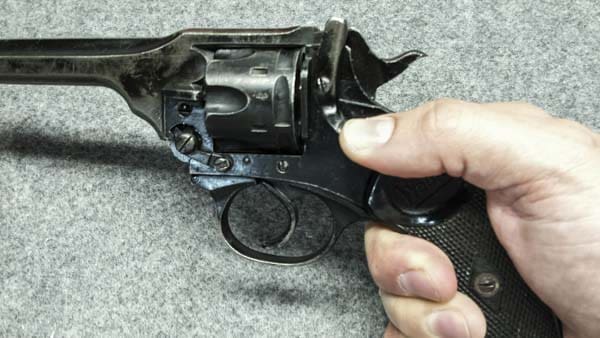
Congratulations! Your revolver has been folded in half!

Now drop in six cartridges (.38 S&W please), hold the grip with one hand and the barrel with the other, and fold it back together. After you have punched some holes in paper, some more fun awaits. Remember that latch? Push is again to make all of your brass cases pop out of the cylinder (it’s really pretty satisfying).
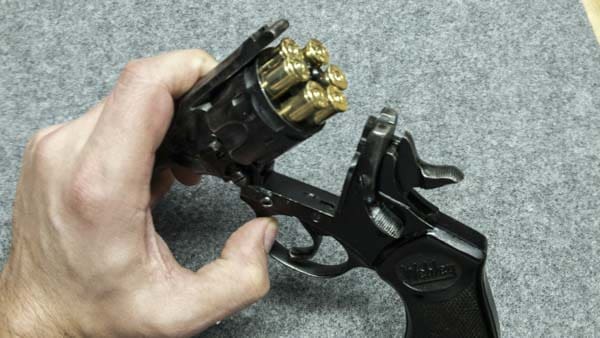
Commercial .38S&W ammo is readily available online. My local gun shop currently has one choice: a brass-cased, 145gr LRN bullet from Prvi Partizan. I have been quite happy with this, though I plan to run some other brands through it as soon as possible. I’m also saving all my brass for the time I jump into reloading (really close to taking this leap).
I should, however, find another gun chambered in .38 S&W so I can justify a bulk ammo purchase. Or maybe I make the bulk ammo purchase first and use that to justify a new gun…decisions. A quick brass comparison of the .38 S&W with others (from left to right: 9×19, .38 S&W, .38 Special, and .45 ACP):
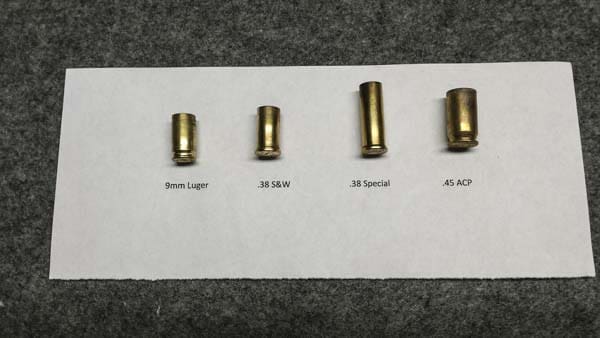
What are the other features you ask? This is a double action revolver, so you can either load it up and start shooting, or pull back the hammer and take some more measured shots. Trigger pull in single action is great (unfortunately I do not have a gauge…it’s on the long list of “stuff other than guns and ammo that would be neat to have”). In double action — I’m not going to lie — it’s approaching Nagant Revolver territory. Not quite there, but damn close. If you shoot more than a box in double action, you might want to think about icing your index finger.
The sights work, plain and simple. The rear sight is a notch, and at the end of the four-inch barrel there is a post. With this gun, you really don’t need anything else, it has proved accurate and consistent over around 250 rounds.
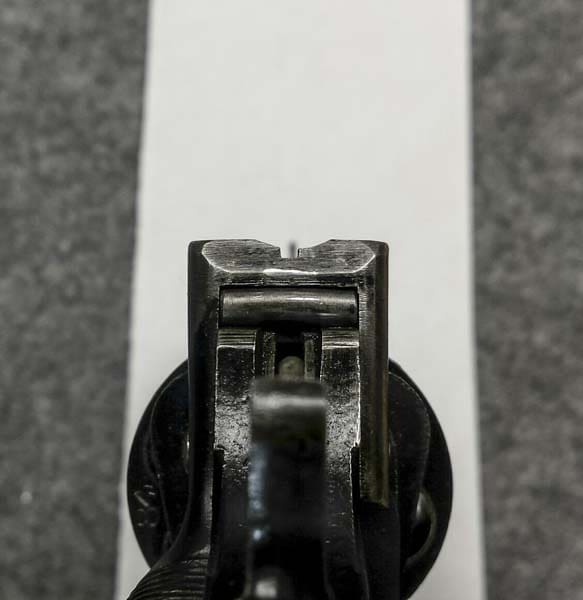
The cylinder of the Webley has a little more play than your standard revolver (thanks to the break-open nature of the gun). This does lock up nicely once the hammer is cocked.
How’s it shoot?
This gun is not light. It’s made out of steel and stout-fueled English sweat (ew). Weighing in at 2.4 lbs. unloaded and 10.25 inches, there is minimal recoil. This allows for faster follow-up shots, and a really fun range experience.
Alright, I have to be totally honest. The below target is not mine. It’s my father’s. I’d love to blame the humidity, the wind, or the dude next to me with the un-lit cigarette in his mouth for about 20 minutes, but I can’t. My old man outshot me (three in single action, three in double action):
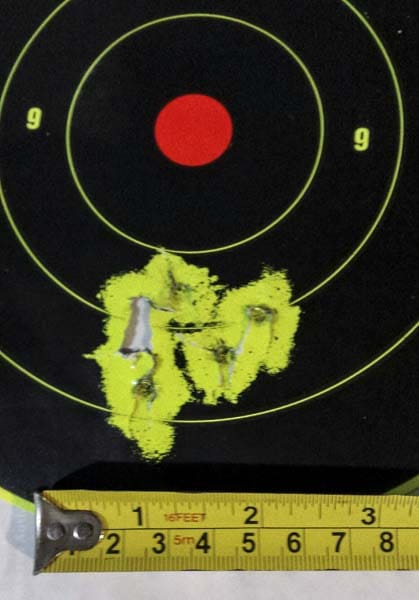
I can, however, say that my less defined group was also low (all of this is measured at seven yards). This makes sense considering the 145 gr. ammo is about 55 gr. lighter than the ammo that this revolver was designed to fire. While my group wasn’t fantastic, I did have great success cleaning up bits of orange clays on the berm behind the target.
It’s a 70+-year-old revolver that points great, barely recoils, has been 100% reliable, and hits what I’m aiming at (if I do my part): What’s not to love?
Customization?
I’m glad you asked. Thanks to the Internet, you can find a variety of replacement parts and reproduction grips. You can even find a canvas holster. But seriously, this is where the gun shines: The Webley Mk IV .38 has a lanyard ring. This means anything that can have a hook attached to it can be an accessory on your Webley:
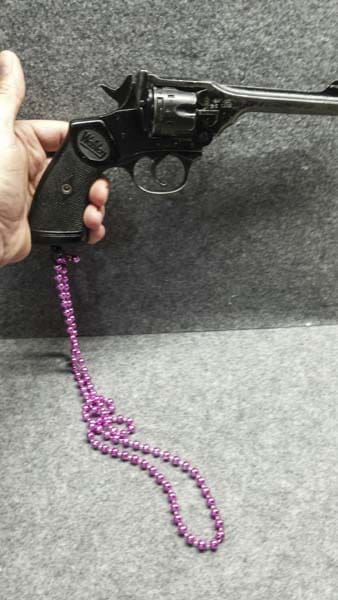
I was going to attach a My Little Pony, but I didn’t want to face the repercussions associated with putting a hook through Rainbow Dash or Twilight Sparkle.
Conclusion
The Webley Mk IV .38 is an accurate and enjoyable revolver. While it’s finish may be worn down, it’s soaked in history. You don’t buy this gun for competition or for self-defense, you buy it to feel closer to our collective past and to have a great range day with your dad.
Be careful when looking to buy one of these. Many retailers/sellers confuse this Webley and the Enfield of the same caliber. The easiest way to spot an Enfield is the different grips (assuming they still have factory grips and not some horrifying homemade wooden set that was painstakingly carved while have-in-the-bag in a garage with a dull knife in the dark).
If you see a bobbed hammer, you’re likely looking at an Enfield No 1 Mk 2* or Mk ** (the stars are important, just ask Google). Become familiar with the various markings on both the Webley and the Enfield and you’ll be able to easily spot the mislabeled listings on Gunbroker and incorrect tags at your LGS. Do your homework, be patient, and pick up a great example of each.
Specifications Webley Mk IV
Caliber: .38 S&W
Capacity: 6
Weight: 2.4lbs empty
Action: Double Action/Single Action
Barrel: 4”
Overall Length: 10.25”
Price: $350 to $500 average sales price on Gunbroker for a decent shooter
Ratings (out of five stars):
Accuracy: * * * *
Pretty darn good. Shoots a little low, but this may be corrected with different commercial loads or maybe some handloads that better meet the original specifications of the .38/200 ammo.
Ergonomics: * * *
Feels great in the hand, points naturally, and has minimal recoil. Nothing fancy, it just works. Double action trigger is a bear.
Reliability: * * * * *
No issues.
Customization: *
Lanyard ring. Options galore.
Overall: * * * *
A great range companion that, after a bit of searching, can be had a decent price. If it’s got history, but it sucks to shoot, it has to be really, really cheap for me to be interested. But this Webley not only made it through the Second World War, it’s also fun at the range.




Webley and Enfield could not make enough revolvers for the brits during the war. S&W made their victory model in the .380/200 and sent them over.
The S&W had a six inch barrel and a solid frame and, at least in my opinion, a better lockwork. In my experience the Webley and the Enfield are perfectly serviceable revolvers but the Victory model is a better shooter.
Still, I’ve always had a thing for top break revolvers.
“…words like cosmoline and Bakelite get me more excited than they probably should.”
You *are* aware Bakelite is a polymer made from… wait for it… *Formaldehyde*, don’t you?
https://en.wikipedia.org/wiki/Bakelite
As excited as an eternal stiffie? 🙂
I use to have a C&R and love curio firearms. Webley are very cool These days you can get CO2 BB version! $180
http://www.pyramydair.com/s/m/Webley_MKVI_CO2_BB_Revolver/3560
Reggie!!!
if you didnt come to kill us why bring that wacking great webley
Always wanted one of these, but the opportunity have never made itself known.
Kudos to Kevin, a young guy with a taste for old guy guns and an understanding of history!
I have a nice postwar made Webley, 1953 or so, that’s marked for the Singapore Police Force.
I also have a S&W Victory Model that is a wartime production.
I reload, so I’m trying to track down the proper 200 gr lead bullet for them.
I have two of these, one in .455 (not modified to .45acp) and one (with a lanyard and holster) in the .380-200. (Bought them 25 years ago when they were not quite as expensive.) Both are fun to shoot, although .455 ammo is a bit spendy. For the ultimate accessory, get yourself a replica Pritchard bayonet for your Wobbly (from Atlanta cutlery). Seriously, chaps, how can you possibly lead the troops over the top without a bayonet attached to your Webley?
http://www.atlantacutlery.com/p-1564-pritchard-pistol-bayonet-reproduction.aspx
Cool thanks for the great link! I just have to find if it will fit my Web Mk I. Never know when you are in the woods and might need to both shoot something with a .455 and do some light (very) close range stabbing!
Appreciate the reviews of the older firearms – love those milsurps. Your historical “conversation” was great – history and humor together made for entertaining reading.
Best review I have read in ages, very entertaining and informative. Author should be on staff as a writer, should win the contest.
Love the history and your style. Thanks for the chat!
hire this dude! that was a fun read
Horrible trigger. Not a joy to shoot. Pissed my former father in law sold it to someone else than me. Not really worth owning anyway.
Good review! And I have a strange and sudden desire to drink a Stone Corral Brewery Scotch Ale…
I don’t know how popular reviews of old guns are on TTAG, but they’re some of my favorite content to read (or write).
I want a Webley Fosbery. Um, ok… that’s really all I have to say.
That Fosbury was a flop (sorry, couldn’t resist).
Wonderfully British! An ugly and clunky revolver in an anemic caliber. As the owner of two No 4 Enfields I want one just to round out the collection. If I’m going to play war in British khaki I’ll carry one of my No 4 Mk 2 rifles and a Browning Hi-Power.
I wish that somebody would do a modern top break revolver in .44 special or .357 magnum. Design it for five or six rounds loaded with full moon clips. Totally possible with today’s metallurgy but nobody would buy one because it wouldn’t say Glock.
Something that I don’t quit- understand is that supposedly the top break revolver is weaker than the S&W side crane design. Seems counter intuitive to me- since the crane seems delicate- but S&W made both- and stopped with the top break types.
There actually is a Brit making Webley Mk 7’s in .357- open your checkbook!
https://revivaler.com/anderson-wheeler-mark-vii-357-magnum-revolver/
Why would you need clips for a rimmed cartridge, hmmm?
I think the comment about clip, full-moon or half-moon, was to facilitate a quick reload. There were speed loaders for revolvers available, though apparently not in wide use, before WWI. At least there were for Webley’s. It is worth remembering that the Soviets continued to use revolvers through WWII that loaded and ejected empty shells exactly the same way, more or less, as the Single Action Army Colt.
By the way, S&W produced a 9mm K-frame revolver for a few years in 3-inch and 4-inch versions. It had a special ejector that eliminated the need for clips (the 9mm being a rimless cartridge). I had one and it worked perfectly well. Speedloaders were also available for that cartridge, too, although I never had any for the 9mm. I thought the speedloaders for a .38 special were a little clumsy and prone to releasing their rounds at the wrong time. It was something that you needed to practice with. There was also a 9mm rimmed cartridge (not a rimmed 9mm Luger) but it’s considered obsolete now.
My best friend’d dad has a Webley-Fosbery along with a standard .455 Webley, and I’ve wanted one ever since he first let me see them in high-school.
Both pistols have been in their family since they were new and belonged to his great-great-grandfather back in Wales, who was a chief constable during WW1. He gave them to my friend’s great-grandfather when they emigrated to Michigan just prior to WW2.
The Fosbery’s story didn’t end there; it was stolen during a burglary back in the late ’90s, was recovered, and somehow disappeared from the police evidence locker. My friend’s dad thought it was long gone, until about ten years later he found it for sale on Gunbroker. So he contacted the seller who was a pawn-shop owner, proved that it had been stolen twice, and it was returned free of charge post haste.
I too, have a fondness for top-breaks and have always wanted a .455 Webley. Love your enthusiasm and the history. Thanks.
While I have a .38 Mk IV just to fill the spot in the safe, my first Webley/Enfield was and is a 1926 Mk VI.
As part of the British de-militarization in the ’70s, thousands had the rear of the cylinder faced off to take .45ACP in moons (well, half-moons, since that’s all we had in those days) or even .45 Auto Rim.
I recall buying mine in a midsize Chicago-area gunshop in late ’73 or so. The price was $75. The shop had a box of them, and I picked mine out without a clue of what I was supposed to be checking.
I eased the mainspring down a bit and just plain shot the thing for many years. I liked it with the old Speer swaged 250 grain wadcutter and a modest dose (I think) of Unique.
Fast forward to the early 2000’s and I’d gotten hooked on USPSA action shooting. While I am by birth a “1911” guy- we called them “Colt .45s” back then- I did occasionally take a sixgun to the match just to change up.
I had low-quality Smith 625 I’d bought new that gave nothing but trouble. One day I tried the Enfield alongside during a range session and found out I wasn’t giving much up with the Mk VI, and the Limey was more reliable.
I ran about two seasons alternating between the L-10 .45 and the Enfield. In a truly shocking moment, I attended an all-classifier match and had the shoot of my life- I broke into “B” Class, Revolver Division with the old clunker.
I’ve had a lot of adventures in action shooting sports since then, but no story beats making B with a Webley.
Good review.
I don’t mean to take away from the review, but MAC dropped a video of the Webley just today. Thought I’d share.
https://www.full30.com/video/d458a0e6db5aba7d33774e72b2bb1332
Nice write up. I’ve had a hankerin’ for a Webley lately. Anybody else into “Peaky Blimders”?
Thanks everyone for reading! It was a fun gun to review!
I’m a small-time Webley collector now, I suppose: I have a proper .455 I never really shoot, because it’s the crown jewel of my collection and .455 is basically impossible to find these days. I also recently got a Mark IV, but it’s a bit of an oddball one: the serial number says it’s from 1964, and it’s a Singapore Police Force model. It has an ‘SPF’ stamp on the backstrap, and most unusually, a factory-installed safety behind the hammer.
I’m going to be shooting it and my No. 1 Mk. III* at the next two-gun match at the local range, in mid-September. That should be a riot.
Try Midwayusa.com – Fiocchi makes .455
https://www.midwayusa.com/product/167595/fiocchi-ammunition-455-webley-mark-2-262-grain-lead-round-nose-box-of-50
Fiocchi makes one run a year, and it sells out almost instantly. I haven’t seen any in stock since 2014.
Great review and fun to read. Good job.
The Webley saw the Brits through the greater portion of WWII, and it did exactly what it was intended to do. Gave officers and rear area pogues something to shoot when things got hairy. I love the picture of the officer leading his troops at El Alamein with his Webley in hand.
http://media.gettyimages.com/photos/soldiers-and-officers-of-the-british-infantry-attacking-among-the-picture-id141557204
Supposedly the .38 S&W was more popular than we realize today. I have even seen a Ruger Speed-Six in that chambering, although it sat on the dealer’s shelf for a long time. A U.S. Army field manual also listed the S&W revolver in that chambering, which, among other things, they referred to as “.38 regular.” Apparently they were used to some extent in American service, too.
My buddy and I each bought a Webley Mark 4 pistol back in 1960 because we were going to go on a camping trip from our home in Brainerd, Minnesota to Montana and had heard that we might encounter snakes so we wanted to be prepared. He got a 45 and I got a 38. When we got out to Montana we loaded our pistols and my buddy’s went off. After “Are you OK?” and “Is the car OK?” we both decided that we should just unload them and leave them in the car before one of us got shot! I can’t remember who we bought them from but I do remember that they cost $15 plus $3 for Railway Express shipping. I think that I have only shot one box of bullets in these 58 years!
I have always wanted a break-top revolver. Having read this review some weeks ago renewed in me the urge to get a Webley Mark IV .38. Well, I had a hell of a time finding one, but have finally succeeded on the Internet. (It is on its way, even as I write this.) Because of this review, I was alert enough to reject an Enfield that a guy was trying to pass off as a Webley a couple of weeks ago. (He said he was misinformed.) Thanks very much for that!
.38S&W was a reasonable popular cartridge in the US prior to WWII. Also known as .38 Colt New Police. One can often find reasonable deals on early to mid-20th century Colt & S&W revolvers where the same or similar gun in .38 Spl would be an arm and a leg. Earlier designs like the Safety Hamerless and various top-break are also modestly priced.
In addition to “top brand” weapons, vast quantities of second, third and fourth tier weapon were made in this caliber. Good serviceable Iver Johnson and H&R gun are often not much more than $100 and about 10 years about I bought give interesting “suicide specials” at $85 For the lot.
For those who get an urge to load .38 S&W, keep in mind that the bore is a hair bigger than a .357 bullet, usually .359 or .360. Sometimes you can get properly sized bullets, but hardcast .357 pills are often rather inaccurate. Soft lead, and especially hollow -based wadcutters, are your friend.
An older US Army field manual refers to the .38 S&W as the “.38 Regular,” which always makes me laugh.
I have seen a fair number of older firearms at reasonable prices but none at modest prices. A local shop has a Spanish .32 ACP “Ruby” pistol at around $300, which is neither modest or reasonable. But it comes with a holster.
it used the fire mape ,luger , and 38kolet ?
If you love to wear polyester fabric jackets? so check Salt N Pepa Jacket which is a most selling outfit in our store, Shop now and get amazing discounts and offers.
Dieses Video stellt das neue Verfahren der narbenlosen Haartransplantation vor. Der Patient hat einen enormen Haarausfall und eine verminderte Region. Unabhängig von allem hatten wir die Möglichkeit, bis zu 3.000 Verbindungen zu sammeln, zum Beispiel ungefähr 7.000 Haare. Dies bedeckte ein riesiges Stück seiner Haarspärlichkeit. Ein paar Monate nach der Tat erreichte uns die Patientin, um erneut einen Haarwechsel zu versuchen. Während seines Besuchs waren wir dann bereit zu sehen, dass sich seine kleine gegebene Region, die nach und nach mehrfach beseitigt worden war, vollständig erholt hatte. Darüber hinaus hatten wir die Möglichkeit, eine Aktivität mit 700 Gewerkschaften zu wiederholen. Einmal mehr, ein halbes Jahr nach der Tat, hatte sich die gegebene Region erholt und unser Experte hatte die Möglichkeit, noch einmal einen fünften Kraftstoffaustritt zu spielen. Heute sehen wir wieder, dass sich die Beitragsregion zu 70% erholt hat und unser Pelzexperte ohne Probleme zu seiner 6. Vermittlung weitermachen wird, die Sie in diesem Video finden.